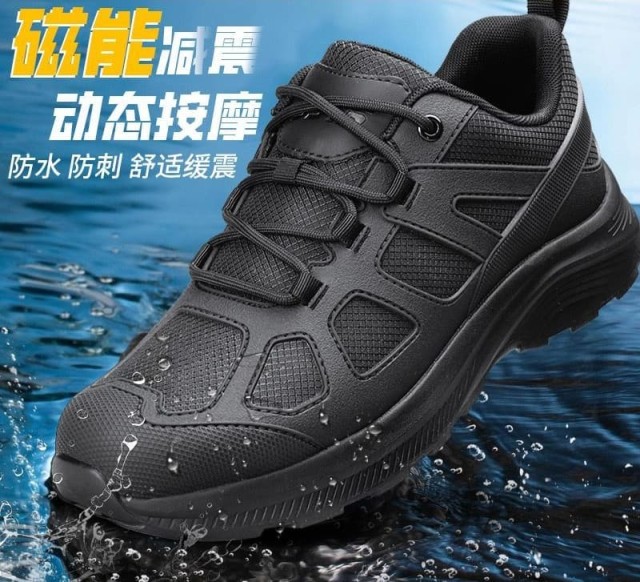Workplace safety isn't just about hard hats and high-vis vests—it starts from the ground up. Waterproof membranes in safety footwear play a critical role in preventing slips, fungal infections, and long-term musculoskeletal issues. This article explores the technology behind these membranes, their direct impact on injury prevention, and how to choose the right footwear for maximum protection.
The Critical Role of Waterproof Membranes in Workplace Safety
Slips and falls account for a significant percentage of workplace injuries, many of which stem from inadequate footwear. Waterproof membranes act as an invisible shield, blocking external moisture while allowing sweat vapor to escape. This dual function maintains dryness—a key factor in preventing:
- Slip-and-fall accidents: Wet surfaces reduce traction by up to 50%, increasing fall risks.
- Skin breakdown: Prolonged moisture exposure softens skin, making it prone to abrasions and infections.
- Cold stress: Wet feet lose heat 25x faster, elevating risks of frostbite in cold environments.
Regulatory bodies like OSHA align with ASTM standards (e.g., ASTM F2413-2005) to ensure footwear meets compression, puncture, and slip-resistance benchmarks.
How Waterproof Breathability Works: Technology Behind the Protection
Waterproof membranes are ultra-thin polymer layers laminated between the shoe’s outer material and lining. Here’s how they function:
- Barrier Effect: Microscopic pores (smaller than water droplets but larger than vapor molecules) block liquid water while permitting sweat evaporation.
- Seam Sealing: Stitched areas are sealed with waterproof tape to prevent leakage—critical when flexing the foot during movement.
- Durability: High-quality membranes resist abrasion from debris, maintaining protection over time.
Without this technology, boots absorb water like sponges, creating a breeding ground for hazards.
Health Risks of Wet Feet: Beyond Discomfort to Serious Hazards
1. Trench Foot and Fungal Infections
Common in agriculture and construction, trench foot develops after 12+ hours in damp conditions. Symptoms include numbness, swelling, and tissue decay. Waterproof footwear reduces this risk by:
- Maintaining a dry microclimate around the foot.
- Preventing bacterial/fungal growth (e.g., athlete’s foot), which thrives in moisture.
2. Slip-Related Injuries
A study of manufacturing workers found that 60% of slip incidents occurred on wet floors. Membranes mitigate this by:
- Preserving outsole grip by keeping the footbed dry.
- Reducing the weight gain from waterlogged materials that alter gait.
3. Long-Term Musculoskeletal Strain
Wet footwear increases weight by ~20%, forcing workers to expend more energy per step. Over months, this contributes to:
- Knee and hip joint stress.
- Chronic fatigue, lowering overall productivity.
Real-World Impact: Industry Case Studies and Safety Compliance
Construction Site Success: Reducing Slip Injuries with Advanced Membranes
A Midwest U.S. construction firm reported a 40% drop in slip incidents after switching to ASTM-compliant waterproof boots. Key outcomes included:
- Fewer workers’ compensation claims for ankle sprains.
- Improved morale during rainy seasons.
Agricultural Workers: Combating Trench Foot and Fungal Infections
Dairy farm workers wearing non-waterproof boots showed a 3x higher incidence of foot infections compared to those with membrane-equipped footwear.
Choosing and Maintaining Waterproof Safety Footwear for Maximum Protection
Selection Criteria:
- Certifications: Look for ASTM F2413-2005 or ISO 20345 labels.
- Material: Opt for breathable membranes (e.g., ePTFE) over coated fabrics for long-term comfort.
- Fit: Ensure a snug fit to prevent friction blisters—common in oversized wet boots.
Maintenance Tips:
- Clean Regularly: Mud and chemicals degrade membrane adhesives.
- Inspect Seals: Check for peeling tape or worn stitching monthly.
- Dry Properly: Avoid direct heat; use newspaper to absorb internal moisture.
Upgrade Your Safety Standards with 3515 Footwear
Distributors and bulk buyers trust 3515’s ASTM-compliant safety footwear to protect workers across industries. Our waterproof membranes combine cutting-edge technology with ergonomic designs—because dry feet are the foundation of a safe, productive workforce. [Contact 3515 today] to equip your teams with reliable protection.
Products You Might Be Looking For:
Explore waterproof safety footwear options
Related Products
- Wholesale Customizable Suede Safety Boots - Puncture-Proof with Velcro Closure
- Wholesale Durable Camo Canvas Shoes with High-Traction Rubber Soles
- Durable Leather Moc Toe Work Boots for Wholesale & Custom Manufacturing
- Durable Mid-Cut Tactical Boots for Wholesale & Private Label
- Durable Moc-Toe Wedge Work Boots | Wholesale Manufacturing for Brands
Related Articles
- How to Choose Work Boot Materials for Maximum Safety and Durability
- How to Choose Work Boots That Match Your Job's Safety Demands
- How to Choose Work Boots That Balance Safety, Comfort, and Durability for Your Job
- Steel Toe Work Boots: Balancing Safety and Comfort for Demanding Jobs
- How to Choose Work Boots That Match Your Job Demands and Safety Needs



















